Anthurium Plants
Anthurium plants are as majestic in appearance as their name. These gorgeous, “flowering” houseplants are easy to care for and make wonderful, long-lasting gifts! Known as the world’s longest-blooming houseplant, Anthuriums add simple beauty wherever you place them.
What is an Anthurium Plant?
The anthurium plant, scientifically known as the Anthurium andraeanum, is a sturdy, glossy-leaved tropical plant. Their “flowers” are not true flowers. In fact, they’re reddish-pink, waxy leaves with thick, textured pistils. Both the leaves and the blooms are lovely, heart-shaped growths.
These plants are also commonly called the Flamingo Flower, the Flamingo Lily, and the Painted Tongue plant. These names are inspired by the beautiful color of the hardy, flower leaves. Many people believe the anthurium is a symbol of long-lasting friendship and love!
- Plant Size – Anthuriums are small to medium-sized houseplants. This plant will typically reach its maximum height at 16 inches, although some can grow even taller. The deep green leaves droop at an angle from the stems and can reach up to 8 inches in length!
- Light – The anthurium plant requires bright, indirect light. The more light they get, the more “flowers” it will produce! Although they don’t tolerate direct sunlight well. Their leaves will likely burn if they’re exposed for too long.
- Watering – Anthuriums enjoy moderately damp soil at all times, but too much water can cause root rot. In general, wait until the top inch of their soil has mostly dried before giving them more water. A typical watering schedule for an anthurium is once every one to two weeks.
- Temperature/Humidity – Anthurium plants thrive in warm, humid climates. Average household temperatures (65° to 75°) are a good climate for these plants, especially if they get plenty of warm, indirect light. To keep their humidity up, you can mist these plants once or twice a week.

Why Choose an Anthurium Plant for Your Home?
One of the best features of these plants is that they’re almost always in bloom! As long as it gets the right amount of light, this plant should continuously grow colorful flowers all year long. Since they’re not real flowers with delicate petals, cleaning up dead blooms becomes a thing of the past.
Anthuriums are also great for purifying the air! According to Nasa’s 1989 Clean Air Study, they can help remove airborne ammonia, formaldehyde, xylene, and toluene. Anthurium plant care is easy, and they take care of you and your family in return!
Anthurium Plant Family Relatives
You may have already noticed that anthuriums are extremely similar in appearance to a few other common houseplants like peace lilies and pothos. That’s because they’re all in the same, tight-knit family – Araceae! Check out these beautiful, beneficial plants below.
Pothos
Pothos, scientifically known as Epipremnum aureum, don’t produce “flowers” like other members of their family. They’re a green (sometimes variegated with white and light yellow) houseplant. Pothos do not tolerate bright or direct light AT ALL, making them the perfect plant for low-light homes.
In addition to low light, pothos only need water about once every two to three weeks. If you’re a forgetful person, pothos are an awesome houseplant for you. Their vine-like stems dangle over the edges of their pot, sometimes reaching six feet in length! Pothos are beautiful in hanging baskets.
Peace Lilies
Spathiphyllum, much more commonly known as peace lilies, look quite a bit like the anthurium plant. In fact, anthuriums are sometimes referred to as red peace lilies! The main difference between them is the shape of the leaves. Peace lilies have rounder leaves than anthuriums.
Final Thoughts
Anthuriums are wonderful, easy plants for people who want a pop of color but don’t want to tend to delicate flowers. The thick, waxy leaves are hardy and resilient, and the long-lasting blooms are uniquely beautiful. It only makes sense that they’re a symbol of enduring love and friendship!